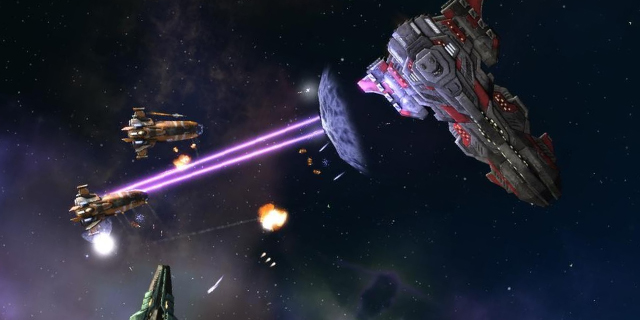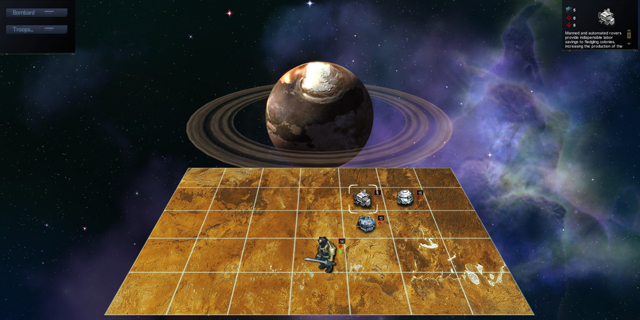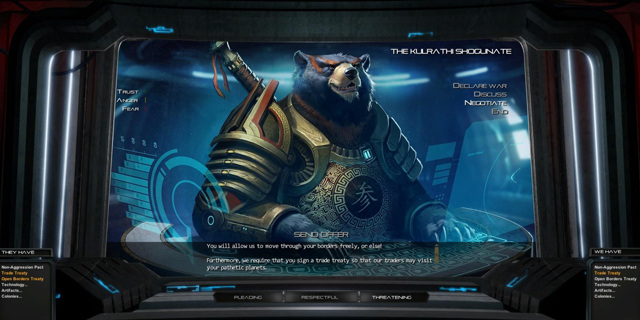
4X games are something of a weakness for me. It almost doesn’t matter what the content is; I’ll dig in for at least a couple of days, as long as it’s playable. That said, it takes something interesting to keep me coming back. StarDrive has what it takes, but it can be tough to get into it.
In case you are unfamiliar with the term, 4X refers to a strategy genre in which you attempt to explore (the galaxy), expand (your empire), exploit (your resources) and exterminate (your competition). StarDrive attempts to combine this customarily turn-based style of gameplay with a real-time engine, much like Sins of a Solar Empire did, though on a galactic scale. In a welcome nod to the fact that many fans of this genre prefer to take their time and think over their moves and strategies, StarDrive allows a player to pause at any time and issue as many orders or queue as many construction orders as you could want. Once it is unpaused, the game will begin following all commands that were entered before. This is great for planning out system defense during wars, trying to time invasion tactics, or even just to get a handle on exactly what is going on in every pocket of your (hopefully) vast empire.
The sheer amount of depth and gameplay systems in this game is remarkable. What planets you decide to colonize will depend on their max population, arability and mineral richness. These all affect how helpful a planet will be at producing buildings, ships and troops, feeding and funding your empire and improving your technology. Each planet has a slider you can set yourself or let the AI manage, that sets how the population divides its focus between food, production and science. Buildings can improve yields in any of those areas, give bonuses to credits or ship building or even increase your planetary defense. This is important, because the AI is very good at bypassing defending fleets and invading your planets. When you find yourself at war, I definitely urge you to increase ground defenses as much as you can.

Feint tactics
Nothing can ever beat successfully defending a planet from a superior fleet by flying in guns blazing and then running away, drawing your opponent into chasing you right into the deadly maw of a battlestation bristling with more firepower than anyone should ever have.
Ground defense is a fairly simple grid-based real-time/turn-based hybrid affair, and it could definitely use some tweaking. Right now it isn’t really feasible to manually control it once your troops land because, while troops do have a timer between moves, the AI reacts so much faster when the timer runs out that you are at a complete disadvantage. Also, time out in the galaxy keeps moving too, so focusing on ground combat is an easy way to lose track of your fleets and lose an entire squadron. While the AI is good at invading, it’s a pain to do so yourself, as you’ve got to find your troops on the planets in your empire, launch them into orbit, select the target planet, wait for them to begin orbiting and then go to the planet’s ground grid and from there set your troops to land and begin their assault. Even something as simple as letting you just click the planet to land without going in would make it so much better.
On a macro scale, exploring is as simple as selecting a ship or fleet and clicking on a destination. Planets need to be scanned directly for detailed information, but solar systems are revealed simply by passing through them. Subspace projectors can be built between colonies to speed travel between, and also give vision of any invading fleets once you gain the technology to do so. In the spirit of past 4X games, StarDrive has a Shipyard you can enter that allows for very detailed and in-depth ship design. There are a few default designs available for many technologies, though you can create as many custom ship templates as you desire, for every hull you have the technology for. Each ship is made up of dozens of small squares that you can drag and drop the different ship parts onto, to fill it up for any purpose you might have. As long as you’ve gained the technology for a ship part, you can place it on a ship. There’s not a lot of feedback on whether a given design will actually perform well in battle, unfortunately, so you could create a ‘legal’ design that turns out to be entirely useless, as I did with a deep space battlestation. I’m still learning how to create a balance between sheer firepower and sustained combat in my designs. My ships hit very hard, but quickly run out of munitions and have to retreat and restock.

Symbiotic sampling
StarDrive takes successful mechanics from other games and combines them into a largely-successful unique experience. With some patching and tweaking, I can see this becoming one of the best 4X games we’ve gotten in years.
There’s also a fleet creator, where you can lay out a fleet formation ship-by-ship and then requisition the necessary ships from already-built ones (or send orders for new ships to your planets, and they’ll be added to the build queues). This works great for giving a way to quickly and easily create fleets, but the formations don’t seem to actually work. When moving through space, and in combat, fleets never stay in formation. That’s not a huge deal except for when your supply ships are exposed to enemy fire, but there’s really no point in bothering with elaborate formations because of it.
StarDrive also lets you to pick and choose what aspects of your empire you control and which to hand off to the AI. You could, of course, attempt to manually control all the minutiae of the game, but that quickly becomes unwieldy and inefficient. Sure, when all you’ve got is your home planet, a couple scouts and a colony ship, it’s not too difficult to balance scientific goals, production, what systems to explore. But once you add a few freighters to ferry food and colonists between two or three planets, diplomacy with a talking plant, designing ships, building and patrolling fleets to protect from pirates or aliens and a few more scouts… you’ll welcome the ability to let the AI handle the more mundane tasks. The AI is a tricky beast to analyze here, though. On one hand, it does amazingly well at handling freighter and supply line logistics and makes some surprisingly effective fleet tactics decisions. On the other hand, it does a poor job of efficiently exploring new systems and assigning colony ships and fleet requisition orders.
Large swaths of StarDrive’s systems are borrowed from prior 4X games like Galactic Civilizations, Master of Orion and Endless Space, but the one area that is completely its own is in the alien races. There are only eight races, but each of them, aside from Terran, is unique. In any given game you might face off against the Opteris, a race of robotic dragonflies; the Pollops, a race of intelligent plants; the religious and violent Ralyeh; the Kulrathi Shogunate, a race of space bears who speak in haiku; or even the Cordrazine, a race of mollusks who have a race of enslaved owls that do all their dirty work. Each race is interesting and unusual, so it’s slightly disappointing that they don’t actually play much differently from each other. While each race has unique ship designs and differing traits, such as being master ship-builders or physically weak, their AI personalities tend to all act very similarly.
It’s very impressive how smoothly StarDrive lets you zoom in and out in real-time. You could be viewing a quarter of the galaxy one moment and zoom up close to a single ship the next. It can chug along later on in the game at times, but overall it runs very well considering just how much is being displayed and running at any given time.
StarDrive is very rough around the edges. It does a poor job of explaining itself, many systems are obtuse until you spend a lot of time using them, some aspects of the AI need work and there are stability issues late in the game. But underneath that is a diamond of a game, one that has the complexity and depth of systems to draw me back anyway.
Pros: Unique races, detailed ship designer, great tactics and strategy
Cons: Hard to figure out how mechanics work, late game slowdown, planet invasion is too complicated



















